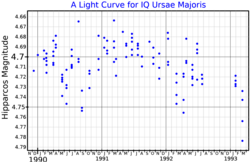83 Ursae Majoris
| Observation data Epoch J2000 Equinox J2000 | |
|---|---|
| Constellation | Ursa Major
|
| Right ascension | 13h 40m 44.27335s[2] |
| Declination | +54° 40′ 53.8891″[2] |
| Apparent magnitude (V) | 4.69 - 4.75[3] |
| Characteristics | |
| Spectral type | M2 III[4] |
| B−V color index | +1.630±0.006[5] |
| Variable type | SRb[3] |
| Absolute magnitude (MV) | −1.39[5] |
| Details | |
dex | |
| Database references | |
| SIMBAD | data |
83 Ursae Majoris is a candidate
Gaia Early Data Release 3 parallax is 179 pc.[13] The system is moving closer with a heliocentric radial velocity of −18.6[6]
km/s.
The visible component is an evolved red giant with a stellar classification of M2 III.[4] It is a marginal barium star, showing an enhanced abundance of s-process elements in its outer atmosphere. This material may have been acquired during a previous mass transfer from a now white dwarf companion, or self-enriched by a dredge-up during the asymptotic giant branch process.[14]
References
- ^ "Hipparcos Tools Interactive Data Access". Hipparcos. ESA. Retrieved 8 December 2021.
- ^ S2CID 18759600.
- ^ S2CID 125853869.
- ^ S2CID 123149047.
- ^ S2CID 119257644.
- ^ S2CID 59451347.
- ^ ISSN 0004-6361.
- S2CID 166227927.
- S2CID 119246448.
- ^ "83 UMa". SIMBAD. Centre de données astronomiques de Strasbourg. Retrieved 2018-03-31.
- S2CID 14878976.
- Bibcode:1994IBVS.4114....1P.
- S2CID 228063812.
- Bibcode:1997A&A...319..881G.

